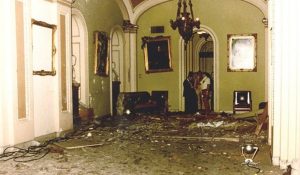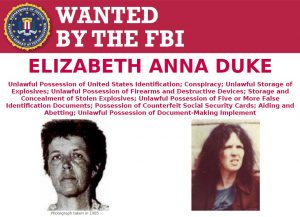As many have noted, the January 6th storming of the U.S. Capitol by a violent right-wing mob was the first successful seizure of the structure since it was taken by the British in 1814. However, it was not the first time that domestic extremists had targeted the capitol building. In 1954, armed Puerto Rican nationalists wounded five members of Congress in a shooting spree. In 1971, the radical left Weather Underground detonated a bomb in a north wing restroom that caused minor damage. Most recently, in 1983, a Marxist-Leninist terrorist group exploded a bomb that caused extensive damage to the Senate side of the building. This incident, though now largely forgotten, was arguably the most destructive domestic terror attack on the U.S. Capitol prior to January 6.
The Bombing

On the night of November 7, 1983, just moments after a phone warning was received, a bomb detonated on the second floor of the north (Senate) wing of the capitol. An article on the Senate history website describes the damage:
The force of the device, hidden under a bench at the eastern end of the corridor outside the chamber, blew off the door to the office of Democratic Leader Robert C. Byrd. The blast also punched a potentially lethal hole in a wall partition sending a shower of pulverized brick, plaster, and glass into the Republican cloakroom. Although the explosion caused no structural damage to the Capitol, it shattered mirrors, chandeliers, and furniture. Officials calculated damages of $250,000. (Bomb Explodes in Capitol)
There were no casualties. The bombing was claimed by the “Armed Resistance Unit,” as a response to recent American military interventions in Grenada and Lebanon. The name “Armed Resistance Unit,” investigation would reveal, was a cover adopted by a group whose real name was the May 19th Communist Organization.
The May 19th Communist Organization

In 1978, a radical Marxist-Leninist faction split off from the Weather Underground to form their own group. They called themselves the May 19th Communist Organization, in honor of the mutual birthday of Malcolm X and North Vietnamese communist leader Ho Chi Minh. While the May 19th organization was largely white, it did ally itself with radical Black and Puerto Rican groups, even aiding in two 1979 prison escapes. One unique aspect of the group was that it was mostly founded and led by women.
Historian William Rosenau describes the May 19th organization as follows:
They are sort of an offshoot of the Weather Underground, which essentially cracked up in the mid 1980s. These women decided to continue the armed struggle. Many of them had been in the Weather Underground, but they thought the Weather Underground had made important ideological mistakes, that the Weather Underground saw itself as a vanguard of revolution, when in fact the real revolutions were going on in the third world. Or in the United States itself, in places like Puerto Rico or among Native Americans. (Quoted in Thulin, “In the 1980s”)
The capitol bombing was just one of a number of terrorist actions the May 19th organization undertook in order to support Third World revolutionary movements. The group was involved in several armored car robberies, and committed a handful of other bombings in the New York and Washington, D.C. areas. None of the bomb attacks resulted in fatalities, and all followed the same basic script. In Rosenau’s words: “a warning call to clear the area, an explosion, a pre-recorded message to media railing against U.S. imperialism or the war machine under various organizational aliases (never using the name M19).” (Quoted in Thulin, “In the 1980s”)
In the wake of the U.S. Capitol bombing, the group became a major target of FBI counterterrorism efforts. Even as May 19th became ever more radicalized, contemplating both targeted assassinations and no-warning bombings, the group began to break apart under FBI pressure. The first members were arrested in 1985. In 1988, six members of May 19th were charged with the U.S. Capitol attack as well as several other bombings. Three were convicted in 1990.
While the May 19th Communist Organization largely ceased to exist in the mid-1980s, several members remain at-large, and are sought by the FBI to this day.
Federal Documents Sources:
Current and Proposed Security Relating to the U.S. Capitol Building and Grounds: Master Plan for the U.S. Capitol Grounds and Related Areas. Subcommittee on Public Buildings and Grounds of the Committee on Public Works and Transportation, House of Representatives, Ninety-Eighth Congress, First Session. November 15, 1983. (Joyner Docs Stacks: Y 4.P 96/11:98-52)
Domestic Security Measures Relating to Terrorism. Hearings Before the Subcommittee on Civil and Constitutional Rights of the Committee on the Judiciary, House of Representatives, Ninety-Eighth Congress, Second Session. 1984. (Joyner Docs Stacks: Y 4.J 89/1:98/51)
FBI Oversight and Budget Authorization. Hearing Before the Subcommittee on Security and Terrorism of the Committee on the Judiciary, United States Senate, Ninety-Eighth Congress, Second Session. March 14, 1984. (Joyner Docs Stacks: Y 4.J 89/2:S.HRG.98-895)
FBI Oversight and Budget Authorization for Fiscal Year 1986. Hearing Before the Subcommittee on Security and Terrorism of the Committee on the Judiciary, United States Senate, Ninety-Ninth Congress, First Session. April 3, 1985. (Joyner Docs Stacks: Y 4.J 89/2:S.HRG.99-208)
The Weather Underground. Report by the Subcommittee to Investigate the Administration of the Internal Security Act and Other Internal Security Laws of the Committee on the Judiciary, United States Senate, Ninety-Fourth Congress, First Session. January 1975. (Joyner Docs CWIS: Y 4.J 89/2:W 37)
Additional Sources:
Bomb Explodes in Capitol: November 7, 1983. United States Senate Website.
McGreevy, Nora. “The History of Violent Attacks on the U.S. Capitol.” Smithsonianmag.com, January 8, 2021.
Rosenau, William. Tonight We Bombed the U.S. Capitol: The Explosive Story of M19, America’s First Female Terrorist Group. New York: Atria Books, 2019. (On Order for Joyner Library)
Thulin, Lila. “In the 1980s, a Far-Left, Female-Led Domestic Terrorism Group Bombed the U.S. Capitol.” Smithsonianmag.com, January 6, 2020.